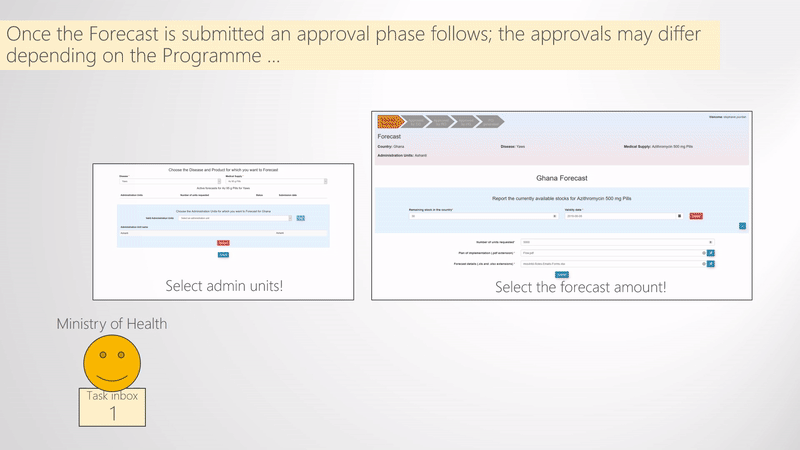Difference between revisions of "Forecasting Medical Supplies"
(→Video) |
|||
| (185 intermediate revisions by the same user not shown) | |||
| Line 1: | Line 1: | ||
| − | The Process of Forecasting Medical Supplies requires the coordination and communication between different actors. In this wiki you can find information on how this process evolves from | + | The Process of Forecasting Medical Supplies requires the coordination and communication between different actors. In this wiki you can find information on how this process evolves from start to end. Overall the process is logically separated into five different sub-processes (actions) that are explained below. |
| − | |||
| − | |||
| − | + | [[File:forecasting-high-level.jpg|900px|center|thumb|text-top|High Level view of Forecasting Process]] | |
| − | + | == Call for forecast (WHO NTD Programme Manager)== | |
| − | |||
| − | |||
| − | + | <strong> Forecasting </strong> is the process of calculating the needs of a country with respect to medical supplies for a given NTD, for a certain period of time. The calculation of the quantity needed for a country is performed by the country officials (i.e., [[WIMEDS Actors#Ministry of Health (MoH)| Ministries of Health]]) in collaboration with WHO medical officers at the respective countries (i.e., [[WIMEDS Actors#WHO Country Office (CO)|WHO Country Office]] and [[WIMEDS Actors#WHO Regional Office (RO)|WHO Regional Office]]). Once the quantity is calculated, the medical supplies need to be requested from WHO. This calculation is performed on a periodic fashion (e.g., yearly), and the actor that actually initiates the process is the [[WIMEDS Actors#NTD Programme Manager| NTD Programme Manager at WHO HQ]]. Thus, every year, at a given period of time the Programme Manager (WHO-HQ) sends automatic emails through WIMEDS to notify countries that they can start their Forecasting process. The way this is triggered in WIMEDS is | |
| − | + | shown visually in the '''Call for forecast''' figure. | |
| − | [[ | ||
| − | + | [[File:1.CallForecast_new.gif|thumb|center|text-bottom|800px|alt=Call For Forecast |<strong>Call for forecast:</strong> the Programme Manager in a periodic fashion (e.g., yearly) starts the process by sending emails to countries that have signed an agreement with WHO. Legend: filled arrows represent the flow of tasks, dashed blue arrows represent the flow of emails (e.g., notification, action, reminder)]] | |
| − | |||
| − | [[File: | ||
| − | === | + | === Call for forecast that requires a set of approvals === |
| − | WIMEDS can be | + | In certain scenarios the emails that are sent by the [[WIMEDS Actors#NTD Programme Manager| NTD Programme Manager]] can be received by [[WIMEDS Actors#Ministry of Health (MoH)| Ministries of Health]], only if they have first been approved by the [[WIMEDS Actors#WHO Regional Office (RO)|WHO Regional Office]] and the [[WIMEDS Actors#WHO Country Office (CO)|WHO Country Office]]. WIMEDS is configurable in order to support such cases. This is depicted in '''Call for Forecast with and without approvals'''. |
| + | [[File:2.EmailApproval.gif|thumb|center|text-bottom|800px|alt=Email Approvals |<strong>Call for forecasting with and without approvals:</strong> when the Programme Manager sends emails to ministries of health, this may need to be first approved by the WHO Regional Office and Country Office. Legend: filled arrows represent the flow of tasks, dashed blue arrows represent the flow of emails (e.g., notification, action, reminder)]] | ||
| − | === | + | ===Video=== |
| − | + | ''' Click on the following link to see a video record of this part of the process: [[:File:CALL-FOR-FORECAST.mov |Call for forecast - VIDEO]] ''' | |
| − | == Forecast | + | == Submit forecast (Ministry of Health)== |
| + | When [[WIMEDS Actors#Ministry of Health (MoH)| Ministries of Health]] receive an email that notifies them that they can perform their forecast, they need to access a web-application that allows them to do so. The process of submitting the Forecast consists of first selecting the '''Disease''', '''Medical supply''', and the '''Administrative divisions''' for which the countries want to forecast. Next, in some cases countries may need to report the '''Available stocks''', select the '''Quantity of the required medical supply''' and upload the '''Documents''' that provide details on the forecasted numbers. A visual representation of how this is done in WIMEDS is shown in the '''Submit forecast''' figure. | ||
| + | [[File:3.PerformForecast.gif|thumb|center|text-bottom|800px|alt=Perform Forecast Forms|<strong>Submit forecast:</strong> 1. Select the disease, medical supply and administrative divisions, and 2. Report the stocks available at the administrative level for the selected medical supply, insert the forecasted quantity and upload the necessary documents. Legend: filled arrows represent the flow of tasks, dashed blue arrows represent the flow of emails (e.g., notification, action, reminder)]] | ||
| − | + | === Select disease, medical supply, and administrative divisions === | |
| − | + | WIMEDS can be used for forecasting medical supplies for different NTD programmes. Therefore, the first thing that needs to be selected is the '''Programme/Disease''' for which the country wants to submit a forecast (typically the country needs to sign an agreement with the NTD Programme first). Next, since NTD programmes may distribute different medical supplies like medicines and diagnostic kits, the ministry of health needs to first select the '''Medical supply'''. Finally, the last thing to be selected in this phase are the '''Administrative divisions''' (e.g., regions, cities, etc.) for which the country is forecasting. | |
| − | == | + | === Report stocks, insert the quantity of forecast, and upload necessary documents=== |
| − | |||
| − | + | After the first form is filled as explained above, the ministry of health needs to fill the information about the '''Stocks''' with respect to the medical supply selected in the previous phase. Next, the information to be provided is the '''Forecasted quantity''' and the necessary '''Documents''' that define the '''''Plan of implementation''''' (a pdf file) and the '''''Forecast details''''' (an Excel document). When this information is submitted, the forecast process starts and that is explained next. | |
| − | == | + | === Video === |
| − | + | ''' Click on the following link to see a video record of this part of the process: [[:File:FORECAST-SUBMISSION.mov |Forecast submission - VIDEO]]''' | |
| − | [[File: | + | |
| + | == Approve forecast (WHO NTD Programme Manager)== | ||
| + | |||
| + | When the [[WIMEDS Actors#Ministry of Health (MoH)| Ministry of Health]] submits the forecast, a forecast approval phase is started. What needs to be approved and validated is the quanity of medical supplies and the corresponding documents. The approval phase typically consists of three steps, namely, approval from the [[WIMEDS Actors#WHO Country Office (CO) | WHO Country Office]], approval from the [[WIMEDS Actors#WHO Regional Office (RO)|WHO Regional Office]], and the [[WIMEDS Actors#NTD Programme Manager (PM)|NTD Programme Manager]] (i.e., WHO Headquarters). Since some of the programmes may not need all the three levels of approval, this part is also configurable. The way this is done in WIMEDS is visually shown in the '''Forecast approval phases''' figure. Note the blue dashed arrows indicate the notification emails sent during the forecast approval phase. That is, all the actors are notified during the different steps of approval. | ||
| + | [[File:4.ForecastApproval.gif|thumb|center|text-bottom|800px|alt=Approve Forecast |<strong>Forecast approval phases:</strong> when the ministry of health submits the forecast, the forecast typically needs to be approved by three different actors. | ||
| + | Legend: filled arrows represent the flow of tasks, dashed blue arrows represent the flow of emails (e.g., notification, action, reminder)]] | ||
| + | |||
| + | ===Video=== | ||
| + | ''' Click on the following link to see a video record of this part of the process: [[:File:FORECAST-SUBMISSION.mov |Forecast approval - VIDEO]]''' | ||
| + | |||
| + | == Finalize forecast and create procurement order (WHO NTD Programme Manager)== | ||
| + | When enough forecasts are submitted and approved by the the NTD Programme Manager, they need to be finalized. The finalization of the forecast consists of selecting the '''Manufacturer''' for each Forecast and potentially deciding the final quantity of medical supplies to be procured (e.g., if some changes need to be applied). Once these are set and submitted, the process of the '''Procurement of the medical supplies''' starts. That is, new tasks are assigned by the [[WIMEDS Actors#NTD Programme Manager| NTD Programme Manager]] to the [[WIMEDS Actors#NTD Technical Officer (TO)| NTD Technical Officer]], who is responsible of the procurement. Thus, the Technical Officer receives a task per country and manufacturer where he uploads the '''Procurement Order''' and notifies the manufacturer. A schematic representation of this is shown in the '''Finalize forecast and create procurement order''' figure. As shown in the figure, the [[WIMEDS Actors#NTD Technical Officer (TO)| Technical Officer]] inserts the Procurement Order ID and uploads the corresponding document to WIMEDS. Note that the '''Procurement ID''' is important since different actors can transparently track the state of the Procurement through its ID. | ||
| + | |||
| + | [[File:5.FinalizeForecast_new.gif|thumb|center|text-bottom|800px|alt=Finalize Forecast and Create Procurement Order |<strong>Finalize forecast and create procurement order:</strong> when the Programme Manager decides to finalize the approved Forecasts, he selects the manufacturers for each Forecast. Next, the Technical Officer creates and uploads the Procurement Orders necessary for procuring the forecasted medical supplies. Legend: filled arrows represent the flow of tasks, dashed blue arrows represent the flow of emails (e.g., notification, action, reminder)]] | ||
| + | |||
| + | ===Video=== | ||
| + | ''' Click on the following link to see a video record of this part of the process: [[:File:PO-SUBMISSION.mov | Finalize forecast and create procurement order - VIDEO]]''' | ||
| + | |||
| + | == Create and dispatch shipment == | ||
| + | Finally, when procurement orders are created for different countries, the [[WIMEDS Actors#Manufacturer| Manufacturer]] is notified and has the task of serving the POs. This process consists of several steps that are explained below and are visually presented in the figure '''Create and dispatch shipment'''. First of all, since the Manufacturer is not always able to serve all the procurement orders at once (e.g., not enough stocks available), it can access an application in order to confirm the available medical supplies. That is, it can provide the quantity of the medical supplies that can be served at the moment. When this quantity is submitted by the Manufacturer, the [[WIMEDS Actors#NTD Programme Manager| NTD Programme Manager]] has the task of splitting this quantity among different procurement orders which are transformed into shipments for different countries, and are served by the Manufacturer. Thus, the Manufacturer can see the shipments assigned to each country and can immediately start the process of shipping the medical supplies and communicating with the corresponding country. See the steps below for more details on how this process evolves. | ||
| + | |||
| + | ===Confirmation of availability (Manufacturer)=== | ||
| + | In case the [[WIMEDS Actors#Manufacturer| Manufacturer]] cannot serve all the Procurement Orders immediately (e.g., not enough stocks available), what it can do is to access an application where it can introduce the quantity of the medical supplies that are available and can be shipped at the moment (not necessarily serving all the Procurement Orders). When this is submitted to the system, the system creates a task for the NTD Programme Manager where he can distribute this quantity among different active POs, thus creating the actual shipment for each country. To this end, a PO for a country can be served by one or more shipments (if there is lack of medical supplies for them to be shipped at once). | ||
| + | |||
| + | ===Create shipments (WHO NTD Programme Manager)=== | ||
| + | The quantity of medical supplies introduced by the Manufacturer is received by the NTD Programme Manager, who distributes this quantity among different countries that have an active (i.e., not fully served) Procurement Order. | ||
| + | |||
| + | ===Confirm shipments (Manufacturer)=== | ||
| + | The shipments created for different countries by the NTD Programme Manager are received by the Manufacturer who needs to confirm them, and has the task of communicating with countries. That is, when the Manufacturer confirms the shipments created by the NTD Programme Manager, every country receives a task of giving the green light to the Manufacturer who can then start the dispatching of the shipment. Furthermore, along with the confirmation, the Manufacturer also uploads/submits the documents required for the issuing of the green light. | ||
| + | |||
| + | ===Give green light (WHO Country Office)=== | ||
| + | |||
| + | Before physically dispatching the medical supplies, the [[WIMEDS Actors#Manufacturer| Manufacturer]] needs to get a green light from the country (i.e., [[WIMEDS Actors#WHO Country Office (CO)|WHO Country Office]]). Thus, the process is performed as follows. The Manufacturer uploads all the necessary documents required for getting the green light. The Country Office is notified by email and receives a task where he/she can check all the documents and if they are correct can give the green light. | ||
| + | |||
| + | ===Dispatch shipment (Manufacturer)=== | ||
| + | |||
| + | When the green light is given, the Manufacturer gets a notification email and receives the task of dispatching the shipment (e.g., providing details about the shipment: estimated date of delivery, flight number, etc.). When this task is submitted, the Country Office receives a new task where he can see all the information provided and also confirm the reception of the shipment. | ||
| + | |||
| + | ===Confirm reception (WHO Country Office)=== | ||
| + | |||
| + | When the shipment is dispatched, the Country Office through email receives the final task of confirming the reception of the medical supplies. Note that this task contains all the information to track the shipment and also is the task where the Country Office can confirm the reception of the medical supplies. That is, when the medical supplies are received in the country, by completing this task, the Country Office informs all the actors that the medical supplies have already been received in the country. | ||
| + | |||
| + | [[File:6.CaManagement.gif|thumb|center|text-bottom|1000px|alt=Create and Dispatch Shipments|<strong> Create and dispatch shipments:</strong> the manufacturer confirms the available medical supplies. This quantity is distributed into shipments for different countries by the [[WIMEDS Actors#NTD Programme Manager| NTD Programme Manager]]. Next, [[WIMEDS Actors#WHO Country Office (CO)|WHO Country Offices]] give green lights for the shipments. The [[WIMEDS Actors#Manufacturer| Manufacturer]] dispatches the shipments and finally, Country Offices confirm the reception of the shipments. Legend: filled arrows represent the flow of tasks, dashed blue arrows represent the flow of emails (e.g., notification, action, reminder)]] | ||
| + | |||
| + | === Video === | ||
| + | ''' Click on the following link to see a video record of this part of the process (if the video does not open, please try it with another browser): [[:File:CA-MANAGEMENT.mov | Create and dispatch shipments - VIDEO]]''' | ||
Latest revision as of 20:15, 27 September 2021
The Process of Forecasting Medical Supplies requires the coordination and communication between different actors. In this wiki you can find information on how this process evolves from start to end. Overall the process is logically separated into five different sub-processes (actions) that are explained below.
Contents
Call for forecast (WHO NTD Programme Manager)
Forecasting is the process of calculating the needs of a country with respect to medical supplies for a given NTD, for a certain period of time. The calculation of the quantity needed for a country is performed by the country officials (i.e., Ministries of Health) in collaboration with WHO medical officers at the respective countries (i.e., WHO Country Office and WHO Regional Office). Once the quantity is calculated, the medical supplies need to be requested from WHO. This calculation is performed on a periodic fashion (e.g., yearly), and the actor that actually initiates the process is the NTD Programme Manager at WHO HQ. Thus, every year, at a given period of time the Programme Manager (WHO-HQ) sends automatic emails through WIMEDS to notify countries that they can start their Forecasting process. The way this is triggered in WIMEDS is shown visually in the Call for forecast figure.
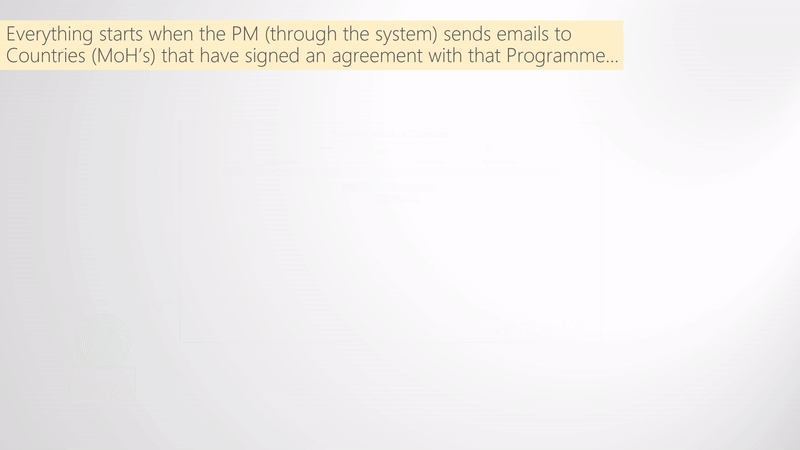
Call for forecast that requires a set of approvals
In certain scenarios the emails that are sent by the NTD Programme Manager can be received by Ministries of Health, only if they have first been approved by the WHO Regional Office and the WHO Country Office. WIMEDS is configurable in order to support such cases. This is depicted in Call for Forecast with and without approvals.
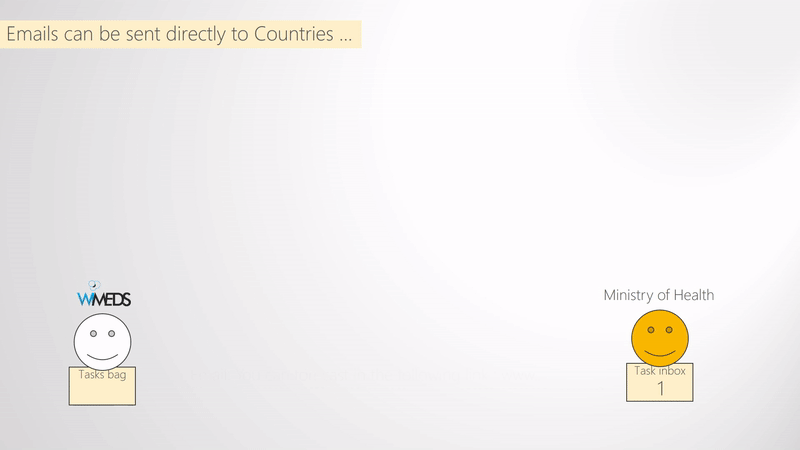
Video
Click on the following link to see a video record of this part of the process: Call for forecast - VIDEO
Submit forecast (Ministry of Health)
When Ministries of Health receive an email that notifies them that they can perform their forecast, they need to access a web-application that allows them to do so. The process of submitting the Forecast consists of first selecting the Disease, Medical supply, and the Administrative divisions for which the countries want to forecast. Next, in some cases countries may need to report the Available stocks, select the Quantity of the required medical supply and upload the Documents that provide details on the forecasted numbers. A visual representation of how this is done in WIMEDS is shown in the Submit forecast figure.
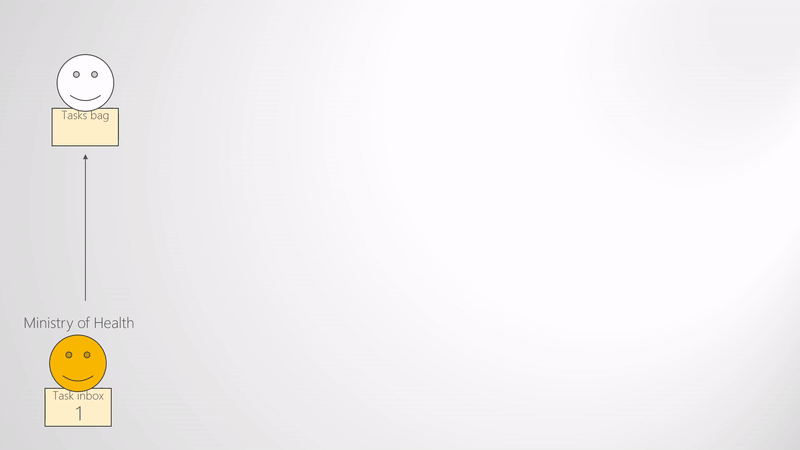
Select disease, medical supply, and administrative divisions
WIMEDS can be used for forecasting medical supplies for different NTD programmes. Therefore, the first thing that needs to be selected is the Programme/Disease for which the country wants to submit a forecast (typically the country needs to sign an agreement with the NTD Programme first). Next, since NTD programmes may distribute different medical supplies like medicines and diagnostic kits, the ministry of health needs to first select the Medical supply. Finally, the last thing to be selected in this phase are the Administrative divisions (e.g., regions, cities, etc.) for which the country is forecasting.
Report stocks, insert the quantity of forecast, and upload necessary documents
After the first form is filled as explained above, the ministry of health needs to fill the information about the Stocks with respect to the medical supply selected in the previous phase. Next, the information to be provided is the Forecasted quantity and the necessary Documents that define the Plan of implementation (a pdf file) and the Forecast details (an Excel document). When this information is submitted, the forecast process starts and that is explained next.
Video
Click on the following link to see a video record of this part of the process: Forecast submission - VIDEO
Approve forecast (WHO NTD Programme Manager)
When the Ministry of Health submits the forecast, a forecast approval phase is started. What needs to be approved and validated is the quanity of medical supplies and the corresponding documents. The approval phase typically consists of three steps, namely, approval from the WHO Country Office, approval from the WHO Regional Office, and the NTD Programme Manager (i.e., WHO Headquarters). Since some of the programmes may not need all the three levels of approval, this part is also configurable. The way this is done in WIMEDS is visually shown in the Forecast approval phases figure. Note the blue dashed arrows indicate the notification emails sent during the forecast approval phase. That is, all the actors are notified during the different steps of approval.
Video
Click on the following link to see a video record of this part of the process: Forecast approval - VIDEO
Finalize forecast and create procurement order (WHO NTD Programme Manager)
When enough forecasts are submitted and approved by the the NTD Programme Manager, they need to be finalized. The finalization of the forecast consists of selecting the Manufacturer for each Forecast and potentially deciding the final quantity of medical supplies to be procured (e.g., if some changes need to be applied). Once these are set and submitted, the process of the Procurement of the medical supplies starts. That is, new tasks are assigned by the NTD Programme Manager to the NTD Technical Officer, who is responsible of the procurement. Thus, the Technical Officer receives a task per country and manufacturer where he uploads the Procurement Order and notifies the manufacturer. A schematic representation of this is shown in the Finalize forecast and create procurement order figure. As shown in the figure, the Technical Officer inserts the Procurement Order ID and uploads the corresponding document to WIMEDS. Note that the Procurement ID is important since different actors can transparently track the state of the Procurement through its ID.
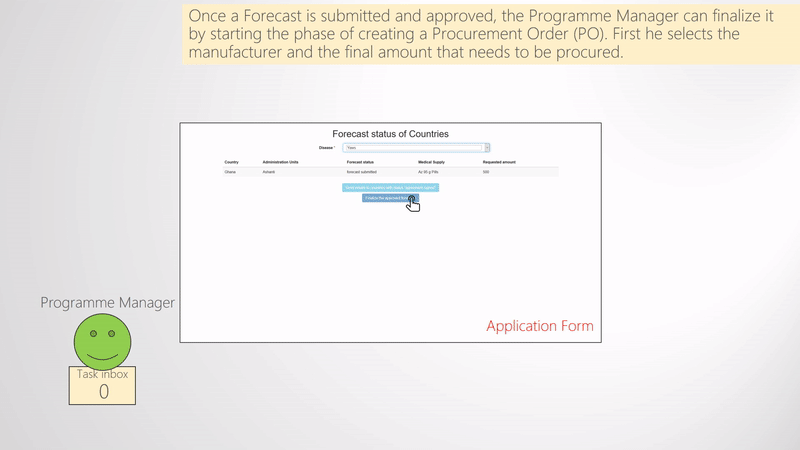
Video
Click on the following link to see a video record of this part of the process: Finalize forecast and create procurement order - VIDEO
Create and dispatch shipment
Finally, when procurement orders are created for different countries, the Manufacturer is notified and has the task of serving the POs. This process consists of several steps that are explained below and are visually presented in the figure Create and dispatch shipment. First of all, since the Manufacturer is not always able to serve all the procurement orders at once (e.g., not enough stocks available), it can access an application in order to confirm the available medical supplies. That is, it can provide the quantity of the medical supplies that can be served at the moment. When this quantity is submitted by the Manufacturer, the NTD Programme Manager has the task of splitting this quantity among different procurement orders which are transformed into shipments for different countries, and are served by the Manufacturer. Thus, the Manufacturer can see the shipments assigned to each country and can immediately start the process of shipping the medical supplies and communicating with the corresponding country. See the steps below for more details on how this process evolves.
Confirmation of availability (Manufacturer)
In case the Manufacturer cannot serve all the Procurement Orders immediately (e.g., not enough stocks available), what it can do is to access an application where it can introduce the quantity of the medical supplies that are available and can be shipped at the moment (not necessarily serving all the Procurement Orders). When this is submitted to the system, the system creates a task for the NTD Programme Manager where he can distribute this quantity among different active POs, thus creating the actual shipment for each country. To this end, a PO for a country can be served by one or more shipments (if there is lack of medical supplies for them to be shipped at once).
Create shipments (WHO NTD Programme Manager)
The quantity of medical supplies introduced by the Manufacturer is received by the NTD Programme Manager, who distributes this quantity among different countries that have an active (i.e., not fully served) Procurement Order.
Confirm shipments (Manufacturer)
The shipments created for different countries by the NTD Programme Manager are received by the Manufacturer who needs to confirm them, and has the task of communicating with countries. That is, when the Manufacturer confirms the shipments created by the NTD Programme Manager, every country receives a task of giving the green light to the Manufacturer who can then start the dispatching of the shipment. Furthermore, along with the confirmation, the Manufacturer also uploads/submits the documents required for the issuing of the green light.
Give green light (WHO Country Office)
Before physically dispatching the medical supplies, the Manufacturer needs to get a green light from the country (i.e., WHO Country Office). Thus, the process is performed as follows. The Manufacturer uploads all the necessary documents required for getting the green light. The Country Office is notified by email and receives a task where he/she can check all the documents and if they are correct can give the green light.
Dispatch shipment (Manufacturer)
When the green light is given, the Manufacturer gets a notification email and receives the task of dispatching the shipment (e.g., providing details about the shipment: estimated date of delivery, flight number, etc.). When this task is submitted, the Country Office receives a new task where he can see all the information provided and also confirm the reception of the shipment.
Confirm reception (WHO Country Office)
When the shipment is dispatched, the Country Office through email receives the final task of confirming the reception of the medical supplies. Note that this task contains all the information to track the shipment and also is the task where the Country Office can confirm the reception of the medical supplies. That is, when the medical supplies are received in the country, by completing this task, the Country Office informs all the actors that the medical supplies have already been received in the country.

Video
Click on the following link to see a video record of this part of the process (if the video does not open, please try it with another browser): Create and dispatch shipments - VIDEO

